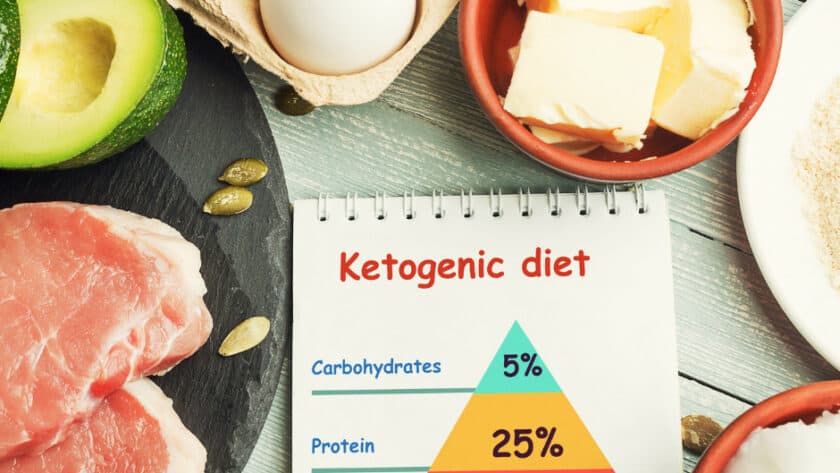Are you ready to embark on a journey to better health and weight loss? The ketogenic diet might just be the answer you’ve been looking for. In this ultimate guide, we’ll cover everything you need to know to succeed on this low-carb, high-fat lifestyle. From understanding the basics of the ketogenic diet to advanced techniques, we’ve got you covered.
Understanding the Basics of the Ketogenic Diet
What is the Ketogenic Diet?
The ketogenic diet, often referred to as keto, is a low-carb, high-fat diet that has been proven to help with weight loss, improve mental clarity, and boost energy levels. The goal of the diet is to shift your body into a state of ketosis, where it relies on fat for fuel instead of carbohydrates.
The Science Behind Ketosis
When you consume a low amount of carbohydrates, your body begins to burn fat for energy. This metabolic state is known as ketosis. During ketosis, your liver starts producing ketones, which are molecules that your body can use as an alternative fuel source. By eating a high-fat diet and keeping your carb intake low, you can effectively reach and maintain ketosis.
Benefits of a Ketogenic Diet
Aside from weight loss, the ketogenic diet offers a wide range of health benefits. Many people experience increased mental focus, reduced inflammation, improved cholesterol levels, and regulated blood sugar levels. Some studies even suggest that the keto diet may help manage conditions like epilepsy and Alzheimer’s disease.
One of the key benefits of the ketogenic diet is its ability to promote weight loss. By restricting carbohydrates and increasing fat intake, the body is forced to burn stored fat for fuel. This can lead to significant weight loss over time. Additionally, the high-fat content of the diet helps to keep you feeling full and satisfied, reducing the likelihood of overeating.
Another advantage of the ketogenic diet is its potential to improve mental clarity and focus. When your body is in a state of ketosis, it relies on ketones for energy, which are a more efficient fuel source for the brain compared to glucose. Many people report increased mental sharpness and improved cognitive function when following a ketogenic diet.
Starting Your Ketogenic Journey
Preparing for the Ketogenic Diet
Before jumping into the ketogenic lifestyle, it’s important to do your research and prepare yourself mentally and physically. Clear out your pantry from carb-heavy foods, stock up on keto-friendly ingredients, and set realistic goals for yourself. Remember, starting any new diet requires dedication and commitment.
Embarking on a ketogenic journey is like setting off on a thrilling adventure. Just like a seasoned explorer, you need to equip yourself with the right tools and knowledge to navigate this uncharted territory. So, grab your metaphorical compass and let’s delve deeper into the world of keto!
Essential Foods for Your Keto Pantry
Building a keto-friendly pantry is essential for success on this diet. Include staples like high-quality fats (such as olive oil and coconut oil), grass-fed meats, low-carb vegetables, nuts and seeds, and dairy products like cheese and heavy cream. Don’t forget to include plenty of water to stay hydrated!
Imagine your pantry as a treasure chest filled with culinary gems that will fuel your body and nourish your soul. Each ingredient carefully selected to support your ketogenic journey. The vibrant colors of the low-carb vegetables, the rich aroma of grass-fed meats sizzling in the pan, and the velvety texture of heavy cream swirling in your coffee – these are the treasures that will transform your meals into a keto masterpiece.
Overcoming the Keto Flu
During the initial transition into ketosis, many people experience what is commonly known as the keto flu. Symptoms can range from fatigue and light-headedness to headaches and irritability. The good news is that these symptoms are temporary and can be minimized by staying hydrated, getting enough electrolytes, and allowing your body time to adjust.
Think of the keto flu as a rite of passage, a temporary storm that you must weather before reaching the calm waters of ketosis. Just like a sailor navigating through rough seas, you can equip yourself with strategies to overcome these temporary challenges. Stay hydrated like a seasoned sailor who never lets go of their water bottle, replenish your electrolytes like a wise captain who knows the importance of balance, and give your body the time it needs to adapt, just like a ship adjusting its sails to catch the wind.
Navigating the Ketogenic Diet
Understanding Net Carbs
Counting net carbs is a crucial aspect of the ketogenic diet. Net carbs are calculated by subtracting dietary fiber and sugar alcohols from the total carbohydrate content. By focusing on net carbs rather than total carbs, you can ensure that you stay in ketosis while enjoying a variety of nutrient-rich foods.
But what exactly are dietary fiber and sugar alcohols? Dietary fiber is a type of carbohydrate that our bodies cannot fully digest. Instead, it passes through our digestive system relatively unchanged. This means that it doesn’t significantly impact blood sugar levels and can be subtracted from the total carb count. On the other hand, sugar alcohols are a type of sweetener that are often used in low-carb products. While they do contribute some calories and carbs, they have a minimal impact on blood sugar levels and can also be subtracted from the total carb count.
Decoding Keto-friendly Labels
When grocery shopping on a ketogenic diet, it’s important to know how to read food labels. Look for products that are low in net carbs, high in healthy fats, and free from artificial additives. But what exactly should you be looking for on those labels?
First and foremost, check the net carb count. Aim for products that have a low net carb count per serving, as this will help you maintain ketosis. Additionally, pay attention to the ingredient list. Avoid products that contain added sugars, high-fructose corn syrup, or any other hidden sources of carbohydrates. Instead, opt for products that use natural sweeteners like stevia or erythritol.
Eating Out While Staying Keto
While eating out on a ketogenic diet can be challenging, it’s not impossible. Many restaurants offer keto-friendly options, such as grilled protein with vegetables or salads with low-carb dressing. However, it’s important to be mindful of certain pitfalls that could derail your keto progress.
One common challenge when dining out is hidden sugars in sauces and dressings. Many condiments and dressings contain added sugars, which can quickly add up and kick you out of ketosis. To stay on track, ask for sauces and dressings on the side, so you can control the amount you consume. Additionally, be cautious of starchy sides like potatoes or rice. Instead, ask for extra vegetables or a side salad to keep your meal low in carbs.
By understanding net carbs, decoding keto-friendly labels, and making smart choices while eating out, you can successfully navigate the ketogenic diet and enjoy its many benefits. Remember, consistency is key, and with a little knowledge and planning, you can achieve your health and wellness goals on this low-carb, high-fat lifestyle.
Advanced Keto Techniques
Intermittent Fasting and Keto
Intermittent fasting is a popular approach that can be combined with the ketogenic diet for even greater health benefits. By restricting your eating window and extending your fasting period, you can enhance fat burning and improve insulin sensitivity. This powerful combination can also promote autophagy, a natural process where your body cleans out damaged cells, leading to potential anti-aging effects. However, it’s important to listen to your body and consult with a healthcare professional before starting any fasting regimen.
When practicing intermittent fasting with keto, it’s crucial to maintain proper hydration and electrolyte balance. Drinking enough water and replenishing your electrolytes can help prevent potential side effects such as headaches, dizziness, or fatigue. Additionally, it’s essential to focus on nutrient-dense foods during your eating window to ensure you’re getting all the necessary vitamins and minerals your body needs to thrive.
Cyclical and Targeted Ketogenic Diets
If you’ve mastered the basics of the ketogenic diet, you may want to explore advanced techniques such as cyclical and targeted ketogenic diets. These variations allow for strategic carb-loading to support intense workouts or events. Cyclical ketogenic diet (CKD) involves cycling between periods of strict keto and higher carb intake. This approach can be beneficial for athletes or individuals who engage in high-intensity exercise, as it provides a temporary boost in glycogen stores for improved performance.
On the other hand, targeted ketogenic diet (TKD) involves consuming a small amount of carbohydrates before or after workouts to provide an immediate source of energy without disrupting ketosis. This technique can be particularly useful for individuals who engage in strength training or explosive activities that require quick bursts of energy. However, it’s important to note that both CKD and TKD require careful planning and monitoring to ensure you maintain ketosis and achieve your desired results.
Keto and Exercise
Exercise is an important component of any healthy lifestyle, and it can be successfully incorporated into a ketogenic diet. While your body may take some time to adapt to exercising in ketosis, many people find that they have increased endurance and improved performance once fully fat-adapted. This is because, in a state of ketosis, your body becomes efficient at utilizing fat as fuel, sparing glycogen for when it’s truly needed.
Experiment with different types of exercise and timing to find what works best for you. Some individuals prefer low-intensity activities like walking or yoga, while others thrive on high-intensity interval training (HIIT) or weightlifting. Remember to listen to your body and adjust your intensity levels accordingly. Additionally, consider incorporating targeted supplements such as exogenous ketones or MCT oil to enhance your energy levels and support your keto journey.
Now that you have all the knowledge you need, it’s time to embark on your ketogenic journey. Remember to stay consistent, be patient with your body, and listen to its signals. With a little dedication and the right mindset, you’ll be well on your way to achieving your health and weight loss goals. Whether you choose to explore intermittent fasting, cyclical or targeted ketogenic diets, or incorporate exercise into your keto lifestyle, always prioritize your well-being and consult with professionals when needed. Here’s to a successful and fulfilling keto journey!





